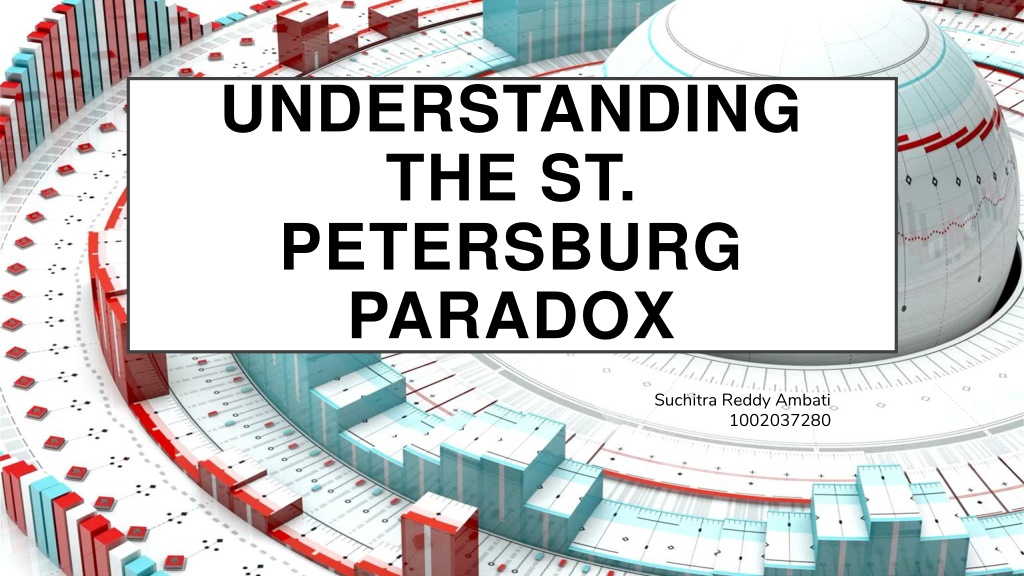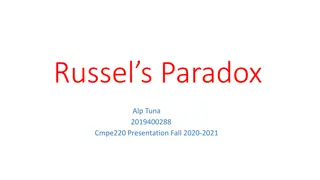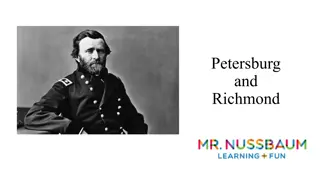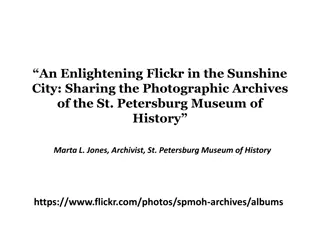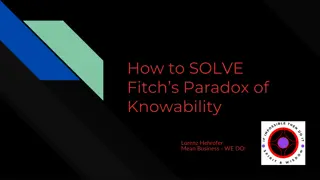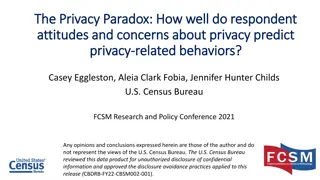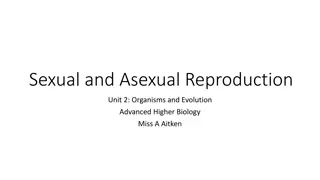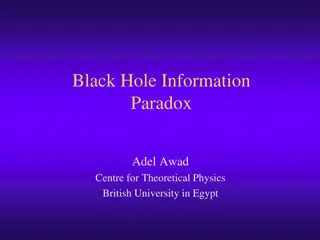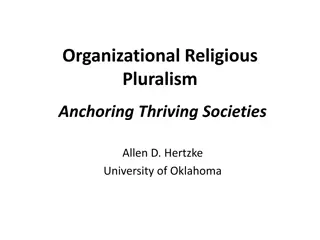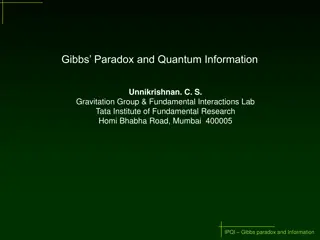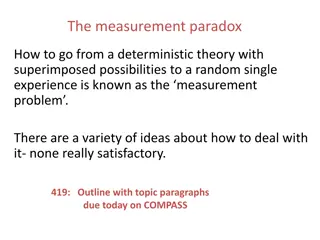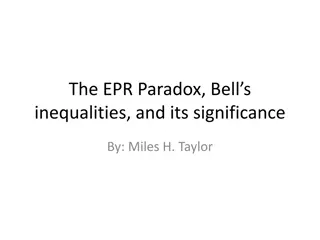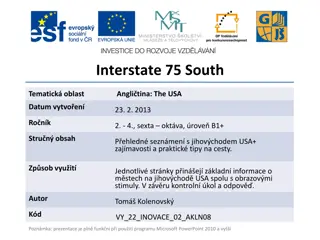Understanding the St. Petersburg Paradox
The St. Petersburg Paradox, a thought experiment challenging traditional decision theory, rational behavior, and more. Understand the infinite expected value in a gambling game, its implications, and the paradox it presents.
Download Presentation

Please find below an Image/Link to download the presentation.
The content on the website is provided AS IS for your information and personal use only. It may not be sold, licensed, or shared on other websites without obtaining consent from the author. Download presentation by click this link. If you encounter any issues during the download, it is possible that the publisher has removed the file from their server.
E N D
Presentation Transcript
UNDERSTANDING THE ST. PETERSBURG PARADOX Suchitra Reddy Ambati 1002037280
INTRODUCTION The St. Petersburg Paradox is a famous thought experiment in probability theory that was first introduced in 1738 by the Swiss mathematician Daniel Bernoulli. The paradox is named after the city of St. Petersburg in Russia, where it is said to have originated. The paradox is significant because it challenges traditional decision theory and our understanding of rational behavior. It has also been used to investigate issues related to risk aversion, expected utility theory, and behavioral economics.
WHAT IS THE ST. PETERSBURG PARADOX? The St. Petersburg Paradox involves a hypothetical gambling game where a fair coin is flipped until it lands on tails. The player receives 2^n dollars, where n is the number of times the coin was flipped before landing on tails. So, for example, if the coin lands on tails on the first flip, the player receives $2^1 = $2. If it lands on tails on the second flip, the player receives $2^2 = $4. And so on. The expected value of the game can be calculated by taking the sum of the probability of each outcome multiplied by its payoff. In this case, the probability of the coin landing on tails on the nth flip is 1/2^n, and the payoff is 2^n dollars. So, the expected value of the game is: This infinite series diverges, meaning it goes to infinity. So, according to traditional decision theory, a rational person should be willing to pay any amount of money to play this game. However, in reality, most people are not willing to pay an infinite amount, leading to the paradox. E(X) = (1/2)($2) + (1/4)($4) + (1/8)($8) + ...
The St. Petersburg Paradox involves a hypothetical gambling game that can be played as follows: 1.A fair coin is flipped until it lands on tails. 2.The player receives 2^n dollars, where n is the number of times the coin was flipped before landing on tails. 3.The player pays an entry fee to play the game. For example, if the coin lands on tails on the first flip, the player receives $2^1 = $2. If it lands on tails on the second flip, the player receives $2^2 = $4. And so on. The entry fee for the game is typically low, such as $1. This means that the expected value of the game is infinite, as we saw on the previous slide. However, most people are not willing to pay an infinite amount to play the game. This creates the paradox, as traditional decision theory would suggest that a rational person should be willing to pay any amount to play the game, but most people are not. THE GAME
EXPECTED VALUE AND HOW IT APPLIES TO THE GAME Expected value = infinity This means that the expected value of the game is infinite, which seems to suggest that the game is extremely profitable and that one should be willing to pay a high price to play it. In probability theory, the expected value is a way to measure the average outcome of a random variable. For the St. Petersburg Paradox, the expected value of the game is calculated by multiplying the payout of each outcome by its respective probability, then summing up the values. For example, if the probability of winning $1 is 1/2, the probability of winning $2 is 1/4, the probability of winning $4 is 1/8, and so on, the expected value of the game is: Expected value = (1/2 x $1) + (1/4 x $2) + (1/8 x $4) + ... Expected value = $1 + $0.50 + $0.50 + $0.25 + $0.25 + $0.125 + ...
THE PARADOX The St. Petersburg Paradox is considered paradoxical because it challenges the traditional economic theory that individuals always make rational decisions based on expected utility. In the case of the St. Petersburg Paradox, the expected value of the game is infinite, which suggests that individuals should be willing to pay any amount to play the game, no matter how high the cost. However, in reality, individuals are often risk-averse and may not be willing to pay a high price to play a game with such uncertain outcomes. This paradox highlights the limitations of expected value as a measure of rational decision-making, and suggests that individuals may also consider other factors such as risk aversion, utility, and personal preferences when making decisions.
There have been various proposed solutions to the St. Petersburg Paradox, including the use of utility theory. Utility theory suggests that individuals make decisions based on their personal preferences, rather than solely on expected value. Other proposed solutions to the paradox include the use of modified probability distributions, such as the geometric distribution, which takes into account the likelihood of individuals continuing to play the game. However, the St. Petersburg Paradox remains a topic of debate and discussion in the fields of economics, probability theory, and decision- making. THE SOLUTION In the case of the St. Petersburg Paradox, individuals may be willing to pay a high price to play the game if they derive a significant amount of utility from the experience, even if the expected value of the game is infinite. This suggests that the value of the game is not solely determined by its expected value, but also by other factors such as personal preferences, risk aversion, and utility.
THE STANDARD ST. PETERSBURG GAMBLE Histogram of bids offered for the standard St. Petersburg paradox. Although the expected value of the gamble is infinite, all bids were finite. The median bid was $1.50. The distribution was bimodal, with large modes at $1 and $2.
THE UTILITY THEORY AND ITS APPLICATION Utility theory is an alternative approach to traditional economic theory, which takes into account the preferences and attitudes of individuals towards risk and uncertainty. It suggests that the value or utility of an outcome is subjective and depends on the individual's personal preferences and attitudes towards risk. In the context of the St. Petersburg Paradox, the utility theory suggests that individuals may not be willing to pay an infinite amount for a gamble with an infinite expected value, as the utility of the outcome decreases as the potential gains become increasingly uncertain and remote.
THE LIMITATIONS OF UTILITY THEORY While the utility theory offers a more realistic approach to economic decision-making, it has some limitations in explaining the paradox. First, it assumes that individuals can accurately assess their preferences and attitudes towards risk, which may not always be the case. Second, it does not account for the possibility of non-monetary factors, such as emotions, social pressure, or personal values, that may influence individuals' decisions.
The St. Petersburg Paradox is an important example of how theoretical constructs can challenge conventional economic wisdom. It highlighted the limitations of traditional economic theory in explaining human decision-making and introduced the concept of expected utility as an alternative approach to economic decision-making. The paradox has had a lasting impact on economic theory and has influenced the development of fields such as behavioral economics and game theory. It has also contributed to the ongoing debate on the role of rationality and uncertainty in economic decision-making. HISTORICAL SIGNIFICANCE OF THE ST. PETERSBURG PARADOX AND ITS IMPACT ON ECONOMIC THEORY
ANALYSIS OF CRITICISMS OF THE ST. PETERSBURG PARADOX AND ITS IMPLICATIONS One criticism of the St. Petersburg Paradox is that it assumes that individuals are risk- neutral, meaning they are indifferent between a certain payoff and a risky gamble with the same expected value. In reality, however, many people are risk-averse, meaning they would prefer a certain payoff to a risky gamble with the same expected value. This has led to the development of alternative theories, such as prospect theory, which take into account individuals' attitudes toward risk. The St. Petersburg Paradox has been the subject of much criticism over the years. Some argue that the paradox is not actually a paradox, but rather a simple demonstration of the limitations of expected value as a tool for decision-making. Others argue that the paradox is not relevant to real-world situations, as few people would be willing to pay an infinite amount for the chance to play a game with a very small probability of a large payout.
Despite its limitations, the St. Petersburg Paradox has important real-life applications in finance and economics. The paradox highlights the limitations of expected value as a tool for decision-making and has led to the development of alternative theories, such as utility theory and prospect theory. These theories are used in finance and economics to better understand how individuals make decisions under uncertainty and risk. REAL-LIFE APPLICATIONS OF THE ST. PETERSBURG PARADOX IN FINANCE AND ECONOMICS The St. Petersburg Paradox has also been used to analyze the pricing of financial derivatives, such as options and futures. These instruments are valued using complex mathematical models that take into account the probabilities of various outcomes. The paradox highlights the importance of understanding the limitations of these models and the assumptions they are based on.
EXTENSIONS TO THE ST. PETERSBURG PARADOX Extensions to the St. Petersburg Paradox have attempted to address the limitations of the original paradox. One such extension is to incorporate the idea of risk aversion. In this case, individuals would not be indifferent between a certain payoff and a risky gamble with the same expected value, as they would prefer the certain payoff due to their aversion to risk. Another extension is to consider the effects of limited wealth on an individual's willingness to pay for the opportunity to play the game. In reality, few people have unlimited wealth, so the idea of an infinite expected value may not be meaningful.
RELEVANCE OF THE ST. PETERSBURG PARADOX IN MODERN ECONOMIC THEORY The St. Petersburg Paradox remains relevant today in the field of economics, particularly in decision theory and behavioral economics. The paradox challenges the traditional economic theory of rational decision-making, which assumes that individuals make decisions based solely on expected values. The paradox highlights the fact that individuals may not always act rationally, and that other factors such as psychological biases and preferences may also influence their decisions. Moreover, the paradox has also led to the development of alternative theories such as utility theory, which takes into account the subjective preferences of individuals. Utility theory has become an essential concept in modern economics, particularly in behavioral economics, which seeks to understand how individuals make decisions in the face of uncertainty and imperfect information.
Despite its continued relevance, the St. Petersburg Paradox has also been subject to controversy and criticism. One of the main controversies surrounding the paradox is its assumption of infinite wealth, which is not realistic in the real world. Some economists argue that the paradox is only a theoretical concept and has little practical relevance. OVERVIEW OF CONTROVERSIES Moreover, the paradox has been criticized for its lack of applicability in situations where individuals have limited information or when probabilities are uncertain. Some economists argue that the paradox is only relevant in idealized situations with perfect information and probability.
CRITICISMS AND RESPONSES Despite these criticisms, many economists and scholars continue to argue that the St. Petersburg Paradox remains relevant and valuable for understanding decision- making behavior. Proponents of the paradox argue that it serves as a useful theoretical tool for exploring the limits of traditional economic theory and the assumptions of rationality. Moreover, some economists have proposed modifications to the original game, such as introducing a maximum bet limit, to address some of the criticisms and make it more applicable to real-world situations. Additionally, researchers have also used the paradox as a basis for empirical studies on decision-making behavior and preferences, contributing to the development of behavioral economics.
COMPARISON TO OTHER PARADOXES The St. Petersburg Paradox is often compared to other paradoxes in economics, such as the Allais Paradox and the Ellsberg Paradox. The Allais Paradox involves a decision-making situation where individuals are presented with two options, both of which have uncertain outcomes. The Ellsberg Paradox, on the other hand, involves decision-making in situations where there is uncertainty about the probability of an event occurring. While these paradoxes are different from the St. Petersburg Paradox in their specific conditions, they all challenge traditional economic theory by highlighting the limitations of rational decision- making models.
EXPERIMENTAL RESULTS Several studies have been conducted to test the St. Petersburg Paradox experimentally. The results have been mixed, with some studies confirming the paradox and others showing that individuals do not behave in the way predicted by the paradox. One study found that participants were more likely to play the game when the potential payout was higher, suggesting that individuals do consider the potential payoff when making decisions. Another study found that participants were less likely to play the game when they had to pay an entry fee, indicating that the cost of participating in the game also influences decision-making.
CONCLUSION The St. Petersburg Paradox is an important concept in economic theory because it challenges traditional assumptions about rational decision-making. The paradox demonstrates that individuals do not always make decisions based solely on the potential monetary outcome, but also consider factors such as risk and uncertainty. The paradox has spurred research in areas such as behavioral economics and game theory, and has led to the development of alternative decision-making models that take into account the limitations of rational choice theory. Overall, the St. Petersburg Paradox highlights the importance of understanding the complex nature of decision-making in economic theory and the need to continue exploring new models to better capture human behavior.
REFERENCES Bernoulli, D. (1738). Specimen theoriae novae de mensura sortis. Commentarii academiae scientiarum imperialis Petropolitanae, 5, 175-192. Pascal, B. (1654). De l esprit g om trique et de l art de persuader. Savage, L. J. (1954). The Foundations of Statistics. John Wiley & Sons. Kahneman, D., & Tversky, A. (1979). Prospect Theory: An Analysis of Decision under Risk. Econometrica, 47(2), 263-291. Von Neumann, J., & Morgenstern, O. (1944). Theory of Games and Economic Behavior. Princeton University Press.
